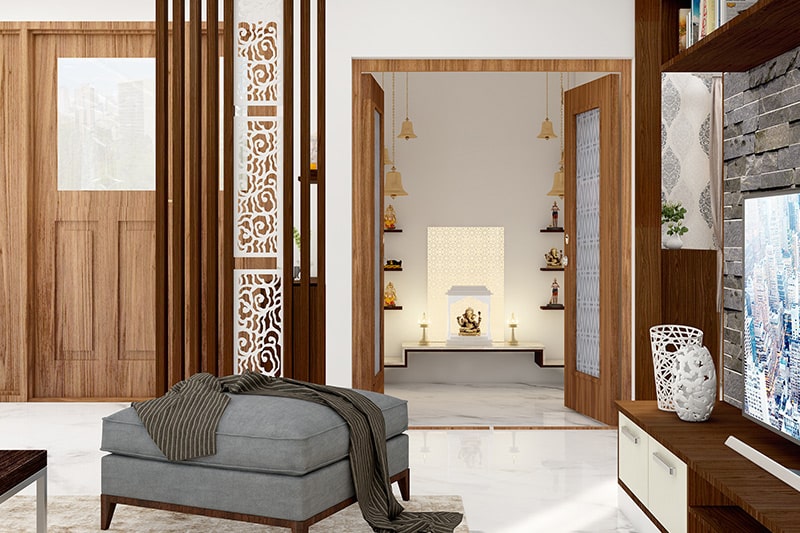In the fast-paced modern world, where the hustle and bustle of daily life can be overwhelming, many individuals are seeking solace in the embrace of sacred spaces within their homes. One such sacred haven is the traditional prayer room, where spirituality intertwines with aesthetics to create an oasis of calm. Crafting a traditional prayer room in a modern home is a soulful endeavor, blending heritage with contemporary design, resulting in a space that resonates with tranquility.
Harmony in Design: Balancing Tradition and Modernity
Designing a traditional prayer room involves a delicate dance between the rich tapestry of age-old traditions and the clean lines of modern architecture. Begin with a thoughtful selection of materials that pay homage to Indian craftsmanship. Incorporate carved wooden panels, antique brass accents, and vibrant fabrics that echo the cultural diversity of India.
Let the prayer room become a canvas for religious symbols and motifs, celebrating the unity in diversity that defines the spiritual landscape of the country. From the auspicious Om symbol to intricate mandalas, each element contributes to the spiritual narrative, fostering an atmosphere of serenity and connection.
Rituals of Light: Illuminating the Sacred Space
In the realm of traditional prayer rooms, lighting plays a pivotal role in creating an ambience that is both warm and inviting. Opt for soft, ambient lighting to envelop the space in a gentle glow. Consider pendant lamps with intricate filigree work, casting captivating patterns of light and shadow that evoke a sense of mysticism.
Introduce diyas or oil lamps to infuse the room with the soft flicker of flames, symbolizing the divine presence. Not only do these traditional lighting fixtures pay homage to cultural practices, but they also bring a timeless charm to the prayer room, allowing the space to transcend temporal boundaries.
Cultural Corners: Blending Heritage with Personal Touch
While adhering to traditional elements, infuse the prayer room with personal touches that reflect your individual spiritual journey. Dedicate a corner to family heirlooms, antique prayer books, or ancestral artifacts that carry the weight of generational spirituality. This creates a connection between past and present, forging a link that transcends time.
Incorporate traditional seating arrangements, such as ornate cushions or intricately woven rugs, inviting contemplation and meditation. The prayer room should be a place of retreat, where one can disconnect from the chaos of the outside world and connect with the divine in a space that is uniquely theirs.
Vibrant Vibes: Color Palette and Symbolism
The color palette of the traditional prayer room is a symphony of hues that resonate with cultural significance. Opt for earthy tones like saffron, deep blues, and muted greens, drawing inspiration from the vibrant landscapes of India. These colors not only contribute to the aesthetics but also hold symbolic meanings rooted in tradition.
For instance, saffron represents purity and spirituality, while blue symbolizes the vastness of the divine. The careful selection of colors not only enhances the visual appeal of the prayer room but also serves as a conduit for spiritual energy, creating an environment that fosters introspection and connection.
Serenading Sounds: Integrating Music and Chants
The auditory experience within a traditional prayer room is as vital as the visual. Consider incorporating a discreet audio system to play soft instrumental music or devotional chants. The rhythmic cadence of such sounds creates an immersive atmosphere, elevating the spiritual experience within the sacred space.
Experiment with sounds of nature, like flowing water or rustling leaves, to establish a harmonious connection with the natural world. This auditory tapestry enhances the prayer room’s ability to provide a sanctuary for meditation and reflection, allowing individuals to escape into a realm of tranquility.
Inclusive Invitations: Making Space for Interfaith Harmony
In the spirit of modern inclusivity, consider designing a traditional prayer room that embraces interfaith harmony. Create alcoves or designated spaces for various religious practices, acknowledging the diverse religious tapestry that is woven into the fabric of Indian society.
This approach not only fosters respect for different faiths but also promotes a sense of unity and understanding. A multicultural prayer room becomes a symbol of peaceful coexistence, transcending religious boundaries and inviting all members of the household to partake in their spiritual journey.
Crafting a traditional prayer room in a modern home is an art that goes beyond mere aesthetics; it’s a testament to the timeless connection between the divine and the individual. By seamlessly blending tradition with contemporary design, one can create a sacred space that resonates with the soul, providing a haven of tranquility in the heart of a bustling world. Embrace the serenity, celebrate the diversity, and let your traditional prayer room be a sanctuary where the spiritual and the modern coalesce in perfect harmony.


